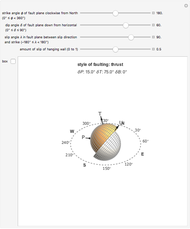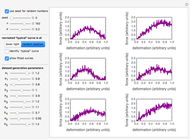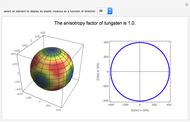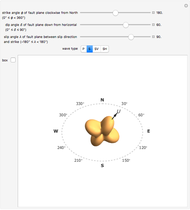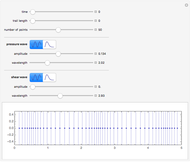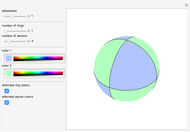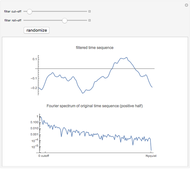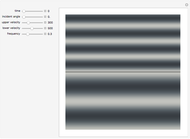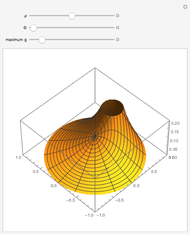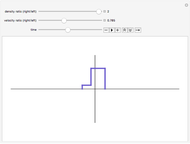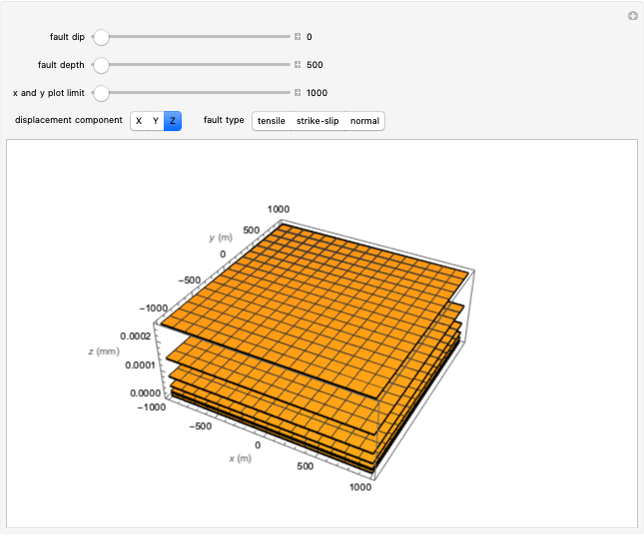Surface Displacements Due to Underground Faults

Requires a Wolfram Notebook System
Interact on desktop, mobile and cloud with the free Wolfram Player or other Wolfram Language products.
This Demonstration shows the displacements (in millimeters) on the surface of a homogeneous half-space due to various elemental dislocations (in meters) at given depths (also in meters) within the half-space, which is equivalent to geologic fault motion. The dip (degrees) of the fault plane is measured from the horizontal, and the depth is measured perpendicularly from the surface. You can specify one of the three components of motion ( ,
,  , or
, or  ) and the fault type. A tensile fault has dislocation normal to the fault plane; a strike-slip fault has dislocation along the fault plane in the horizontal direction (
) and the fault type. A tensile fault has dislocation normal to the fault plane; a strike-slip fault has dislocation along the fault plane in the horizontal direction ( ); a normal fault has dislocation along the fault plane in the vertical (
); a normal fault has dislocation along the fault plane in the vertical ( ) direction.
) direction.
Contributed by: David von Seggern (October 2012)
(University of Nevada)
Open content licensed under CC BY-NC-SA
Snapshots
Details
The mathematical formulas used in this Demonstration are taken from [1], which treats the surface displacements due to planar dislocations at arbitrary depth in a fully elastic half-space. The formulas have been simplified for a Poisson solid (shear modulus  equals Lame's modulus
equals Lame's modulus  ) and for an elemental potency (dislocation times fault area) of 1
) and for an elemental potency (dislocation times fault area) of 1  . Even so, the expressions are fairly complex; however, Mathematica is very efficient in evaluating them for specific parameters. The tensile fault involves a dislocation perpendicular to the fault plane while the strike-slip and normal faults involve dislocations parallel to the fault plane (horizontal and vertical, respectively). The fault plane is oriented along the
. Even so, the expressions are fairly complex; however, Mathematica is very efficient in evaluating them for specific parameters. The tensile fault involves a dislocation perpendicular to the fault plane while the strike-slip and normal faults involve dislocations parallel to the fault plane (horizontal and vertical, respectively). The fault plane is oriented along the  axis, and is rotated around the
axis, and is rotated around the  axis by the dip, starting at 0° dip for a horizontal fault plane and going to 90° dip for a vertical fault plane. The formulation for the strike-slip fault is for what is called right-lateral motion. This means that, for instance, in the case of a 90° dip fault, an observer in the negative
axis by the dip, starting at 0° dip for a horizontal fault plane and going to 90° dip for a vertical fault plane. The formulation for the strike-slip fault is for what is called right-lateral motion. This means that, for instance, in the case of a 90° dip fault, an observer in the negative  half-plane would see the positive
half-plane would see the positive  half-plane move to the right. Results for left-lateral motion are simply the mirror reflection around the
half-plane move to the right. Results for left-lateral motion are simply the mirror reflection around the  axis of the right-lateral results. A similar geometric reflection leads to a reverse fault from the normal fault, with the dislocation of the positive
axis of the right-lateral results. A similar geometric reflection leads to a reverse fault from the normal fault, with the dislocation of the positive  side now going up relative to the negative
side now going up relative to the negative  side rather than down. Results for the reverse fault are therefore obtained by a reflection across the
side rather than down. Results for the reverse fault are therefore obtained by a reflection across the  axis of the normal fault results.
axis of the normal fault results.
Although the results here are for an elemental fault size of 1  , [1] also gives results for fault rectangles of arbitrary size. Those results are not a simple scaling of the elemental fault results. Nonetheless, the results given here for the elemental fault approximate the finite-fault results fairly well when the extent of the finite-fault plane is small relative to the depth of the fault plane. In all cases, for elemental or finite faults, the directions of surface motion are unchanged in the four quadrants of the surface plane.
, [1] also gives results for fault rectangles of arbitrary size. Those results are not a simple scaling of the elemental fault results. Nonetheless, the results given here for the elemental fault approximate the finite-fault results fairly well when the extent of the finite-fault plane is small relative to the depth of the fault plane. In all cases, for elemental or finite faults, the directions of surface motion are unchanged in the four quadrants of the surface plane.
Reference
[1] Y. Okada, "Surface Deformation Due to Shear and Tensile Faults in a Half-Space," Bulletin of the Seismological Society of America, 75(4), 1985 pp. 1135–1154.
Permanent Citation





